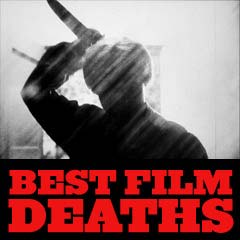
|
Deaths Scenes 1964-1966 |

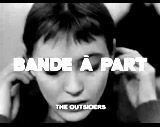
|
Band of Outsiders (1964, Fr.) (aka Bande à part) Jean-Luc Godard's quirky Nouvelle Vague (French New Wave) crime drama was most famous for two scenes performed by its trio of characters:
It told about a love triangle between two young, aspiring, restless, low-life Parisian male criminals:
The two friends dressed like gangsters and dreamed about a life of crime. Both were entranced by beautiful but shy pig-tailed ingenue Odile (Anna Karina) throughout the film. Early in the film, the two men play-acted or pantomimed a legendary shootout in the street between Billy the Kid and Sheriff Pat Garrett. Overacting Arthur rolled around on the pavement pretending painful agony. Three days later, there was also an intense, 90-second, half-hearted face-off/shootout with drawn guns, filmed at mid-distance on the front lawn after a bungled robbery attempt at the villa of Odile's own wealthy Aunt Mme. Victoria (Louisa Colpeyn), where there was reportedly a stash of money. It aped how films were shot in the silent era. The shootout was between Arthur and his crooked Uncle (Ernest Menzer). The uncle fired at Arthur, who took five shots and continued to lurch forward, until the final moment when a single gunshot from Arthur downed his opponent. Arthur then spun dead to the ground in a corkscrew motion. |
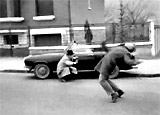 The Play-Acted Shootout  The Real Shootout |
||||||

|
Dr.
Strangelove Or: How I Learned to Stop Worrying and Love the Bomb
(1964, US/UK) In the Doomsday conclusion, in the "Leper Colony" bomber plane, there were two huge nuclear warhead bombs, each labeled with sexual salutations: "Hi There!" (a homosexual advance), and the other labeled "Dear John!" (the typical opening of a letter that ended a relationship). Major Kong (Slim Pickens) saw a sparking tangle of wires, and climbed astride the "Hi There!" bomb like a bucking bronco, fanning the flaring sparks with his cowboy's Stetson hat. Sweating profusely, he busily worked to fuse two wires together to rewire the door circuitry. Captain Ace Owens (Shane Rimmer) asked anxiously: "Roger, 3 miles. Target in sight! Where in hell is Major Kong?" as Kong attached an alligator clip to a patch panel above his head, causing the bomb doors to open wide. The film has given us a memorable cultural image. When the bomb doors opened, he first grabbed onto his Stetson to avoid losing it in the sudden draft of air. The Hi There! bomb was dislodged, with Kong riding on it - the huge bomb [a potent swollen phallic symbol] between his legs. Bombardier Lieut. Lothar Zogg (James Earl Jones) asked:
Kong was flailing the bomb with his hat like a rodeo cowboy atop a bucking bronco, howling yee-haw wildly toward oblivion: "YAHOO!! YAHOO!!" as it malevolently descended toward its target and detonated in a white, climactic flash on the ground.
It was followed by the ironic tune "We'll Meet Again." |
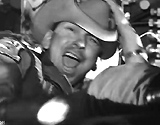 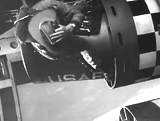 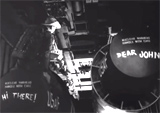 Riding Atop "Hi There!" |
||||||
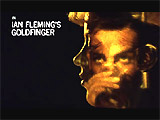
|
In the film's pre-credits sequence, Bond (Sean Connery) was pursuing some "unfinished business" - kissing sexy Latin American barroom dancer Bonita (Nadja Regin) who had just emerged naked from her bath. The 007 agent was attacked from behind by Mexican drug lord thug Capungo (Alf Joint). As he twirled her around after seeing the assassin approaching in the reflection cast in her eye, she was knocked out. He briefly struggled with the man and threw him into Bonita's bathtub - and then as Capungo reached for his gun, Bond tossed a round electric heater fan into the tub water, electrocuting the man to death. As he left, Bond joked: "Shocking, positively shocking." (see further below) |
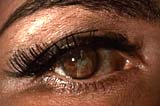 Killer Reflected in Bonita's Eye 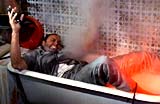
"Positively Shocking" |
||||||

|
It was a striking image - the naked corpse of villainous Auric Goldfinger's (Gert Frobe) escort Jill Masterson (Shirley Eaton) lying on a bed. She had been stripped and painted gold, and then had died of skin suffocation. She was an unfortunate victim of Goldfinger's revenge, punished for her betrayal and collaboration with James Bond (Sean Connery) to help ruin Goldfinger's card-shark scam. She had allowed herself to be seduced by Bond in his hotel suite, but suffered the consequences. Bond reported the death to CIA agent Felix Leiter (Cec Linder): "She's covered in paint. Gold paint." (see further below) |
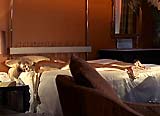 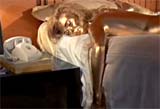 Death by Skin Suffocation |
||||||

|
As the clock ticked down on an atomic device ready to explode inside besieged Fort Knox, Bond (Sean Connery) fought one-on-one against villainous Goldfinger's (Gert Frobe) formally-dressed, smiling, mute Korean manservant Oddjob (Harold Sakata). He tossed the killer's own lethal, steel-rimmed, boomeranging bowler hat at him, but missed. The hat became stuck between steel gate bars. When Oddjob reached for his hat, Bond touched a severed live wire of thousands of volts to the gate, electrocuting him in a shower of sparks. Oddjob died with outstretched arms as he fell forward to the floor. Later, Bond described the death: "He blew a fuse." (see further below) |
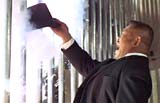 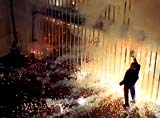 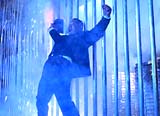 Oddjob's Death: "He blew a fuse!" |
||||||

|
In the film's conclusion, Agent 007 James Bond (Sean Connery) was flying in a Lockheed Martin JetStar bound for Washington DC for a special luncheon with the President. Master villain Auric Goldfinger (Gert Frobe) had unexpectedly tied up the plane's crew in the airport hangar and coerced ex-personal pilot Pussy Galore (Honor Blackman) to hijack the plane and fly him to Cuba. When Bond learned of the devious plan, he struggled against Auric who was holding his gold-plated gun on him. The revolver discharged and blew out one of the plane's windows, causing a drastic loss in air pressure. Bond held on tightly as Auric flew through the air and was sucked out of a tiny window. In the cockpit, Bond joked with Pussy that gold-obsessed Goldfinger was "playing his golden harp." |
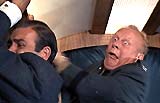  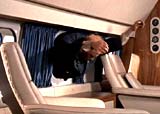 Goldfinger Sucked Out of Airplane Window |
||||||
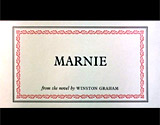
|
Marnie (1964) During a relived flashback scene, Marnie (Tippi Hedren) remembered when she was a young 5 year-old girl (Melody Thomas Scott) who witnessed her 20 year-old prostitute mother Bernice Edgar (Louise Latham) being abused by sex partner and pedophile sailor (Bruce Dern). His actions were misinterpreted when he was calming Marnie during a thunderstorm, by kissing her and stroking her hair. To protect her mother and retaliate when they began fighting and her mother begged for her help, she killed him by beating him over the head with a fireplace poker.
This was the subsequent cause of kleptomaniac Marnie's later 'unnatural fears' regarding sex and men, her problem with the color red, and her sexual frigidity. |
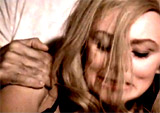 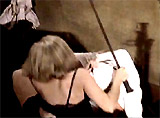 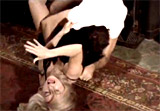
|
||||||

|
Doctor Zhivago (1965, US/UK) In a moving and tragic death scene, aging surgeon Dr. Yuri Zhivago (Omar Sharif) was riding on a street car, when he sighted his old flame Lara Antipova (Julie Christie) walking down a crowded Russian street. He struggled to signal to her, then rushed to exit the streetcar, but the exertion, enormous stress and physical effort was too much for him as he chased after her. He suffered a fatal stroke, as he fruitlessly tried to call out to her. He collapsed and died on the street after failing to get her attention.
A crowd surrounded his lifeless body in a long overhead shot. |
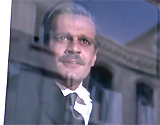 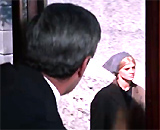 Sighting Lara Walking on Street From Streetcar |
||||||
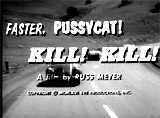 |
Faster, Pussycat! Kill! Kill! (1965) Russ Meyer's exploitation action-cult film was about the misadventures of three, thrill-seeking go-go night-club dancers/strippers who went out to the desert in their sports-cars to commit the crimes of kidnapping and murder:
They terrorized a young couple: Tommy (Ray Barlow) and his girlfriend Linda (Susan Bernard, December 1966 Playmate) - Tommy's back was broken by Varla, while Linda was kidnapped and drugged. After some violent episodes, Billie told her evil companions that she was leaving them. As she was walking away, Varla threw Rosie's switchblade knife a long-distance into her back - Billie staggered and arched backward before falling dead to the ground. Later, when Rosie returned to the scene of the murder to retrieve the knife, muscle-bound and dim-witted Vegetable (Dennis Busch) assumed that she was responsible for the death of his "old man" father (Stuart Lancaster) and he knifed her to death - with three vicious stabs to her abdomen - and she fell dead at his feet. In the film's violent conclusion, during hand-to-hand combat between Varla and the "old man's' older son Kirk (Paul Trinka), Varla was gaining the upper-hand until Linda smashed into her with the jeep and killed her. |
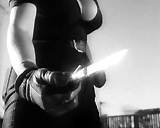  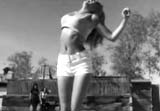 Billie Knifed in Back From Long Distance by Varla 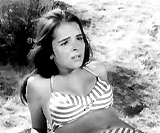 Linda Terrorized 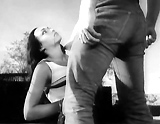 Rosie Stabbed to Death by Vegetable 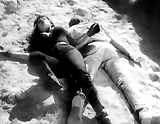 Varla Run Down by Linda |
||||||
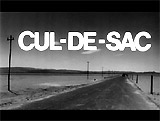
|
Cul-de-Sac (1966, UK) This macabre British black comedy from director Roman Polanski, titled Cul-de-Sac (meaning "dead end"), told about a mismatched married couple who were living in Rob Roy, a secluded, dark 11th-century beachfront castle, situated high on a hill-top on the bleak and remote Lindisfarne Island, Northumberland:
Their home was invaded by on-the-lam, gruff-voiced gangster thug Richard (or "Dickie") (Lionel Stander), who had been mortally-wounded in an accidental occurrence (botched robbery?). He took George and Teresa as hostages. When the tide came in twice daily, the island became encircled by water and access to the castle was impassable. Dickie sought a place to hide while awaiting rescue by a mysterious Mr. Katelbach. Teresa had already been adulterously unfaithful to her husband with their young neighbor Christopher (Iain Quarrier) (she lay bare-breasted on him at the beach). In the conclusion, "Dickie" attempted to hold a machine-gun and fire at the couple, but George went beserk and shot him with his own gun, and "Dickie" fell down dead.
After "Dickie's" death, Teresa left her passive, insane husband, who as the film ended, was sitting alone and sobbing on a rock in the rising water, calling out for his first wife Agnes. |
 "Dickie" (Lionel Stander) 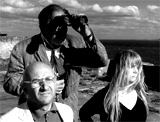 Hostages: George and Teresa 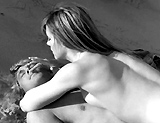 Promiscuous Teresa  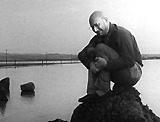 George: Insane and Alone |
||||||
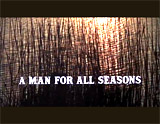
|
A Man for All Seasons (1966, UK) At the conclusion of director Fred Zinnemann's Best Picture-winning film of Richard Bolt's adaptation of his own play, defiant Sir Thomas More (Paul Scofield) - who had stood up to King Henry VIII, was executed by beheading. Before his death, he briefly spoke: "I am commanded by the King to be brief, and since I am the King's obedient subject, brief I will be. I die his Majesty's good servant, but God's first." He then delivered poignant words to his black-hooded executioner, and gave him a coin for his duty:
When the Archbishop Thomas Cranmer (Cyril Luckham) asked: "You're very sure of that, Sir Thomas?", More replied: "He will not refuse one who is so blithe to go to Him." He kneeled, crossed himself, and then bent forward as the executioner quickly struck the fatal downward blow with a curved axe blade. The Narrator concluded the film (in voice-over):
|
 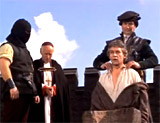 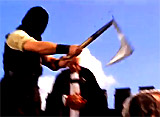 To the Executioner: "You send me to God." |
||||||
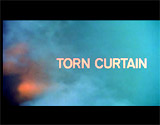
|
Torn Curtain (1966) In Alfred Hitchcock's political/spy thriller, a lengthy murder sequence was set in a farmhouse kitchen, deliberately filmed without background music to emphasize how difficult it was to kill a human being (with one's bare hands without using a gun). It involved the difficult murder of a Soviet agent - German "bodyguard" policeman Hermann Gromek (Wolfgang Keiling) by American physicist and secret double agent Prof. Michael Armstrong (Paul Newman), with the aid of a Farmer's Wife (Carolyn Conwell). During the struggle, there were various different attempts to kill the seemingly invincible German:
|
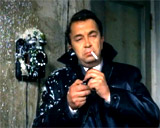 Soup Kettle 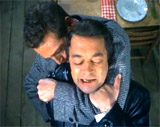 Strangulation 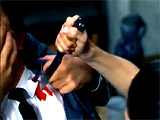
Knifing |
||||||
(chronological by film title) Intro | 1915-1929 | 1930-1933 | 1934-1938 | 1939 | 1940-1942 | 1943-1945 | 1946-1947 | 1948-1949 1950-1952 | 1953-1955 | 1956-1957 | 1958-1959 1960-1961 | 1962-1963 | 1964-1966 | 1967-1968 | 1969-1970 1971 | 1972 | 1973 | 1974 | 1975 | 1976 | 1977-1978 | 1979 1980 | 1981 | 1982 | 1983 | 1984 | 1985 | 1986 | 1987 | 1987 | 1988 | 1989 1990 | 1991 | 1992 | 1993 | 1994 | 1994 | 1995 | 1995 | 1996 | 1997 | 1998 | 1998 | 1999 2000-2001 | 2002 | 2003 | 2004 | 2005 | 2006 | 2007 | 2008 | 2009 | 2010 | 2011 |